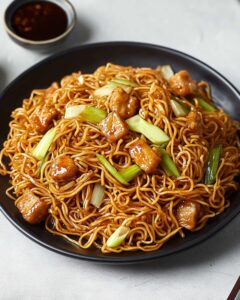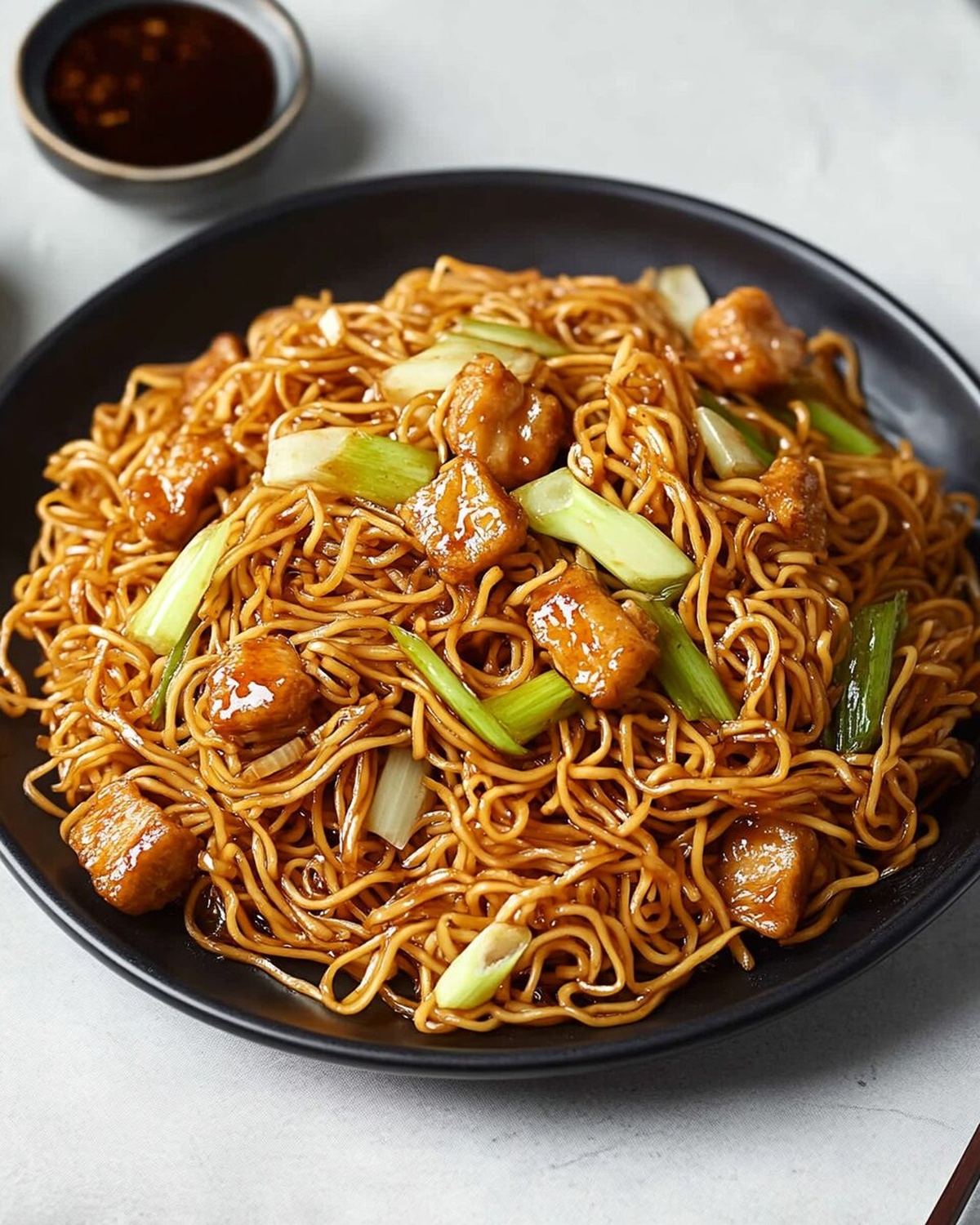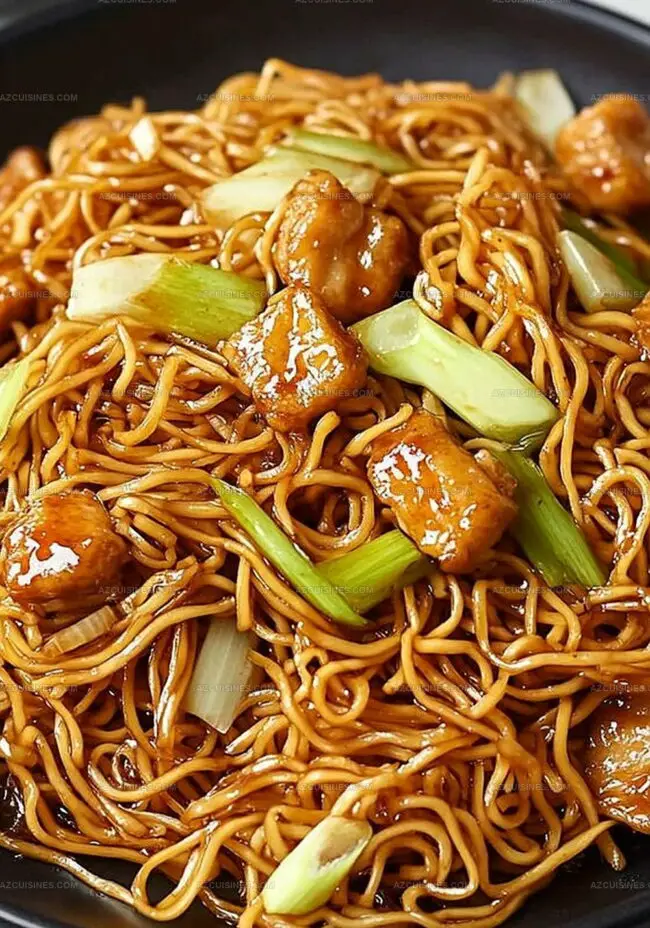Quick & Savory Panda Express Chow Mein Recipe At Home
Craving a delightful chow mein that captures the essence of panda express without leaving your kitchen?
Noodles dance with vibrant vegetables in this quick and satisfying recipe that promises restaurant-quality flavor at home.
Crisp cabbage, tender carrots, and succulent onions create a colorful medley that will make your taste buds sing.
Every twirl of these perfectly seasoned noodles brings a burst of umami and comfort.
Home cooks can easily master this dish with simple ingredients and straightforward techniques.
Watching these golden strands sizzle in the pan feels like culinary magic unfolding before you.
Let’s unlock the secret to recreating this beloved takeout classic that will have everyone asking for seconds.
Why Panda Express Chow Mein Recipe Is A Takeout Favorite
What’s In Panda Express Chow Mein Recipe
Noodles:Vegetables:Sauce and Seasoning:Easy Steps For Panda Express Chow Mein Recipe
Step 1: Whip Up the Flavor-Packed Sauce
Grab a small bowl and mix together the zesty sauce ingredients. Blend them until smooth and set aside, letting the flavors mingle and get excited about their upcoming noodle adventure.
Step 2: Prep the Noodle Base
Bring a large pot of water to a rolling boil. Gently drop in the chow mein noodles and let them dance in the hot water for about 30 seconds.
Quick drain the noodles, making sure they’re perfectly loosened and ready for their stir-fry destiny.
Step 3: Sizzle the Veggie Medley
Fire up a large wok over medium-high heat.
Splash in some vegetable oil and wait for it to get super hot. Toss in a vibrant mix of:Stir and cook these veggies until they become wonderfully soft and slightly translucent, about 1 minute.
Step 4: Create Cooking Space
Slide the cooked vegetables to the side of the wok, creating a sizzling empty space for the next magical step.
Step 5: Bring Everything Together
Pour in the remaining vegetable oil.
Add the prepared noodles and that amazing sauce you made earlier. Toss everything together with confidence, making sure the noodles soak up all those incredible flavors.
Keep stirring until the noodles are perfectly coated and glistening.
Step 6: Serve and Devour
Remove the wok from heat.
Transfer your mouthwatering chow mein to serving plates. Get ready to enjoy a restaurant-quality meal right in your own kitchen!
Tips For Nailing Panda Express Chow Mein Recipe
Tasty Variations On Panda Express Chow Mein Recipe
Perfect Pairings For Panda Express Chow Mein Recipe
How To Store Panda Express Chow Mein Recipe
Panda Express Chow Mein Recipe Questions Answered
Chow mein noodles are thin, yellow wheat-based noodles commonly used in Chinese cuisine. They’re slightly different from regular spaghetti and have a distinctive texture perfect for stir-frying.
Yes, you can swap or add vegetables like carrots, bean sprouts, or mushrooms. Just ensure they’re chopped similarly and cook quickly to maintain their crispness.
Currently, this recipe is vegetarian. However, you can easily add protein like chicken, shrimp, or tofu to make it more substantial.
The original recipe is mild and not spicy.
Print
Panda Express Chow Mein Recipe
- Total Time: 20 minutes
- Yield: 4 1x
Description
Savory Panda Express chow mein noodles bring authentic Chinese-American street flavor straight to kitchen counters. Crisp vegetables and perfectly seasoned noodles deliver restaurant-quality comfort you can easily recreate with simple ingredients and quick cooking techniques.
Ingredients
Main Ingredients:
- 1 pound (454 grams) chow mein noodles or yaki soba noodles
- 2 cups cabbage, thinly sliced
- 1 cup celery, sliced on an angle
- 1 small onion, sliced
Sauce Ingredients:
- 2 tablespoons regular soy sauce
- 2 tablespoons oyster sauce
- 1 tablespoon toasted sesame oil
- 0.5 tablespoon dark soy sauce
- 2 cloves garlic, minced
- 0.25 cup unsalted chicken stock
- 0.5 tablespoon cornstarch
Cooking Oil:
- 2 tablespoons vegetable oil
Instructions
- Whisk together sauce ingredients in a compact vessel, reserving for later integration.
- Immerse noodles in rapidly boiling water for approximately 30 seconds until they become pliable, then immediately drain through a colander.
- Heat wok to medium-high temperature, introducing initial portion of vegetable oil.
- Sauté onions, cabbage, and celery until they develop a tender translucency, roughly 60-90 seconds.
- Shift vegetable mixture toward wok’s perimeter, creating a central cooking zone.
- Pour remaining oil into exposed area of wok.
- Introduce prepared noodles and premixed sauce directly into wok’s center.
- Vigorously toss ingredients, ensuring comprehensive coating and sauce absorption throughout noodle strands.
- Continue stirring until noodles appear glossy and ingredients are uniformly distributed.
- Remove wok from heat source, transferring contents to serving platter immediately.
Notes
- Noodle Blanching Tip: Precisely time the 30-second boiling to prevent overcooking, ensuring perfectly tender yet firm noodles.
- Vegetable Prep Hack: Slice vegetables uniformly for even cooking and consistent texture throughout the dish.
- Sauce Absorption Trick: Let noodles sit in hot wok for an extra 30 seconds after mixing to maximize flavor penetration and create slight caramelization.
- Dietary Adaptation: Swap wheat noodles with gluten-free alternatives like rice noodles or zucchini noodles for celiac or low-carb diets.
- Prep Time: 10 minutes
- Cook Time: 10 minutes
- Category: Lunch, Dinner, Snacks
- Method: Sautéing
- Cuisine: Chinese
Nutrition
- Serving Size: 4
- Calories: 400
- Sugar: 2 g
- Sodium: 800 mg
- Fat: 18 g
- Saturated Fat: 2 g
- Unsaturated Fat: 14 g
- Trans Fat: 0 g
- Carbohydrates: 52 g
- Fiber: 3 g
- Protein: 10 g
- Cholesterol: 0 mg




Truc Tran (Kris)
Senior Food Editor
Expertise
Home Cooking, Meal Planning, Recipe Development, Baking and Pastry, Food Editor, Cooking-video Maker, Vietnamese Food Evaluation Expert
Education
Truc Tran (Kris), an experienced food writer and editor, is great at exploring and describing global cuisines, from simple street food to fancy dining. In her writing, she skillfully mixes different flavors, cooking methods, and culinary traditions, showing the unique character of various cultures through their food and drinks. On azcuisines.com, Kris highlights her knowledge, especially in Asian cuisine and worldwide traditional dishes.